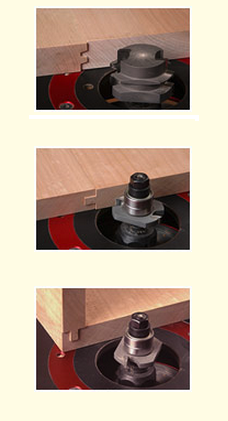I am about to glue-up the top of the base unit to begin building a cherry hutch. In the past year, I bought a set of glue edging cutters for my router table. I have often wondered why I have seen no articles in the many woodworking magazines I have read about using them instead of a plain jointed edge. Can you help me decide which method is best?
-Ronald M.
Bettendorf, Iowa
Our Expert
 For glue to create a strong bond several things must occur with the joint. First, the mating surfaces must make contact. In other words, the modern yellow glue that woodworkers commonly use does not fill gaps. Secondly, the mating surfaces must also be long-grain, as opposed to end grain; it's a known fact that end grain makes a weak glue bond. Finally, the surfaces must cut cleanly. Torn, ragged surfaces can also weaken the joint.
For glue to create a strong bond several things must occur with the joint. First, the mating surfaces must make contact. In other words, the modern yellow glue that woodworkers commonly use does not fill gaps. Secondly, the mating surfaces must also be long-grain, as opposed to end grain; it's a known fact that end grain makes a weak glue bond. Finally, the surfaces must cut cleanly. Torn, ragged surfaces can also weaken the joint.
When all these factors are in place the glue joint, even just a simple edge-to-edge joint, is stronger than the surrounding wood. However, when gluing up a complicated assembly it is often difficult to apply clamp pressure while holding the various parts in alignment. And the glue itself can complicate the matter; it lubricates the parts causing them to slip and slide further out of position. An easy solution is to rout a simple joint along the edges of the parts. A tongue-and-groove or a glue joint bit can be used to increase the glue surface area and keep parts aligned as clamp pressure is applied.
Recommended Tools
Amana Tool No. 55388
Amana Tool No. 55400


 For glue to create a strong bond several things must occur with the joint. First, the mating surfaces must make contact. In other words, the modern yellow glue that woodworkers commonly use does not fill gaps. Secondly, the mating surfaces must also be long-grain, as opposed to end grain; it's a known fact that end grain makes a weak glue bond. Finally, the surfaces must cut cleanly. Torn, ragged surfaces can also weaken the joint.
For glue to create a strong bond several things must occur with the joint. First, the mating surfaces must make contact. In other words, the modern yellow glue that woodworkers commonly use does not fill gaps. Secondly, the mating surfaces must also be long-grain, as opposed to end grain; it's a known fact that end grain makes a weak glue bond. Finally, the surfaces must cut cleanly. Torn, ragged surfaces can also weaken the joint.